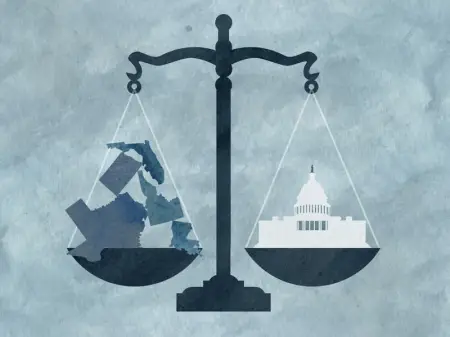In the United States, the national government and the governments of the 50 states have power divided between them and use a system of shared control. Let’s look at the difference between the state and national governments by seeing what the Constitution says they can and cannot do.
Summary Table
| State Government | Federal Government |
| Exercises authority over state issues (licenses, establishment of local governments, state commerce) | Exercises authority over national issues (declaring war, negotiating with foreign states) |
| Powers come from the Tenth Amendment of the Constitution | Powers granted by the Constitution as interpreted by the Supreme Court |
Definitions

The phrase “state government” refers to the governments of the 50 states, which make up the United States. Each of the state governments can create its own laws as long as these laws don’t oppose laws in the Constitution. A state government has complete control over things that happen within the state, but are not allowed to interfere with the actions of other states. All US state governments have equal power internationally, but other countries such as the UK, Germany and France do not recognize individual states as their own sovereign governments.
State governments have the same structure as the federal government, which means they have executive, judicial and legislative branches. The Constitution gives the state governments all powers that aren’t given exclusively to the federal government. This includes powers that are not banned by the Constitution. A good example is the federal government’s power to collect taxes. State governments are also allowed to collect taxes since this is not banned by the Constitution. State governments usually are in control of things inside their borders, including public school policies, driver’s licenses, road maintenance and repair and justice.
The US federal government, also known as the national government, is made up of the three branches established by the Constitution. These branches, or sections, are the executive, judicial and legislative branches. The Founding Fathers did not want any single person or section of government to have unlimited power. To make sure this did not happen, the Constitution was created, and it split up the power of the government into three branches. This system of breaking up government into different sections for protection from corruption is referred to as the system of “checks and balances”.
The executive branch is the part of government that makes sure people follow the laws, and the President is the head of the executive branch. However, the President cannot make laws, and this serves as a “check” on the executive branch. This stops the President from creating laws that can make them more powerful. The part of government that can make laws is called the legislative branch. While the legislative branch has the power to create laws, the President can “check” this power by vetoing these laws. The legislative branch also has to approve people that the President wants to put into office. The judiciary branch is composed of the federal courts that include the US Supreme Court, appeals courts and district courts. The courts that make up the judiciary branch are responsible for determining what the laws mean and to deem whether something is illegal or not.
State vs Federal Government
So, what’s the difference between state and federal governments? The Constitution, as written by The Founding Fathers, balances power between the federal government and the state governments. This is to ensure that power is shared between the state and national governments. While both are composed of three branches (e.g., executive, legislative, judicial) their differences can be seen in the power they exercise as granted by the Constitution.
State governments have jurisdiction over matters that affect their respective states. These would include establishing local governments, issuing licenses (i.e., marriage, driver, hunting), regulating state commerce, conducting elections and more. On the other hand, the federal government exercises its power over matters of national concern. These would include declaring war, printing money, negotiating with foreign governments and regulating both interstate and international commerce.
State governments can also exercise powers not granted to the federal government, and can wield powers that are within the boundaries of the Constitution.





